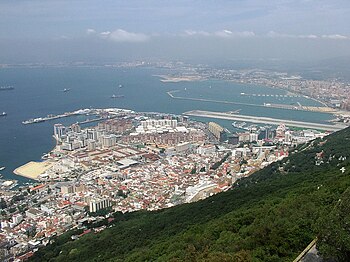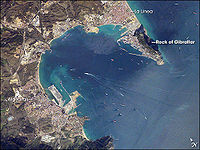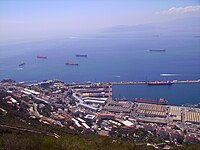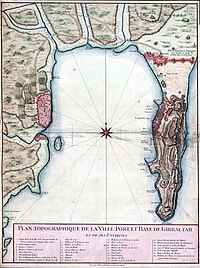Bay of Gibraltar

The Bay of Gibraltar is a bay at the southern end of the Iberian Peninsula, on the Straits of Gibraltar, between Gibraltar to the east and the curving coast of Andalucia to the north and west. It is around 7 miles long and 5 miles wide, covering an area of some 30 square miles, with a depth of up to 220 fathoms in the centre of the bay. It opens to the south into the Strait of Gibraltar.
The shoreline is densely settled. The Spanish coast has several towns, including the industrial port of Algeciras, whose oil refinery is a dominant sight on the horizon from Gibraltar. The larger part of the shoreline is Spanish territory (the Spaniards call it the Bahía de Algeciras; "Algeciras Bay"). The eastern shore of the bay though is Gibraltar and the eastern part of the bay is most often filled with shipping calling at Gibraltar.
The bay's waters are used by a considerable number of large and medium sized ships, notably oil tankers and freighters. Oil bunkering activities are also heavily carried out.
The east and west entrances to the bay are marked respectively by the lighthouses of Europa Point in Gibraltar and Punta Carnero to the west of Algeciras.
Past and present within the bay

The bay is a breeding area for several dolphin species, notably the Common Dolphin, Striped Dolphin and Bottlenose Dolphin, and is also visited by migratory whales. It is a popular destination for tourist whale-watching trips from Algeciras or Gibraltar.
The other major draw for tourists is scuba diving: the area is rich with wrecks and historical artifacts such as crashed Avro Shackleton aircraft and Sherman tanks from the Second World War, and ancient anchors from Phoenician and Roman ships.
Fishing boats weave between the tankers in the bay, braving the currents of the Strait. There has been some trouble of Spanish boats' infringement of British waters, the borderline of which has been contested. After the arrest of a Spanish fishing vessel by the Royal Gibraltar Police in 1998, the problem largely subsided.
Bunkering

The geographical position of Gibraltar on a major shipping route and the capacious facilities it provides ensure that Gibraltar is one of the largest bunkering ports in the Mediterranean, which is to say the supply of fuel to ships. Nearby Algeciras in Spain is another. These two and Ceuta on the opposite shore of the Strait are in the European area second only to the so-called Amsterdam-Rotterdam-Antwerp area for bunkering.[1]
In Gibraltar 4,300,000 tons of fuel were delivered in 2007 compared with just 840,000 tons in 1990 and bunkering is now the main activity within the Port of Gibraltar. Of a total of 8,351 deep-sea vessels which called at Gibraltar in 2007, 5,640 were supplied with fuel.[2]
History

The area around the Bay of Gibraltar has been inhabited for millennia and the bay itself has been used by merchant shipping for at least 3,000 years. The Phoenicians are believed to have had a settlement near Gibraltar and the Romans established the town of Portus Alba ("White Port") on the site of modern Algeciras. Later peoples, notably the Moors and the Spaniards, also established settlements on the shoreline during the Middle Ages and early modern period, including the heavily fortified and highly strategic port at Gibraltar, British since 1704.
The bay's strategic position at the mouth of the Mediterranean has made it a much-contested body of water over the centuries. It has been the site of several major sea battles, notably the Battle of Gibraltar (1607) and the Battle of Algeciras Bay (1801). During the Second World War, Italy launched human torpedoes from Algeciras on several occasions in attempts to sink British ships moored in the Gibraltar harbour, with mixed success due to the work of Commander Crabbe.
Outside links
| ("Wikimedia Commons" has material about Bay of Gibraltar) |
References
- ↑ Algeciras on the ascent, bunkerworld, May/June 2009.
- ↑ Bunkering in Gibraltar
